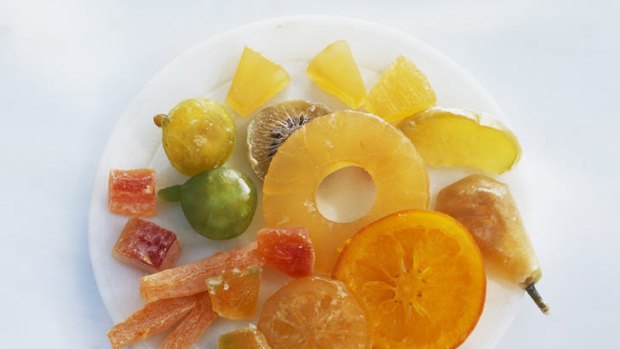By Lissa Christopher
It has become virtually impossible to buy locally-made glace fruit, a reader lamented to Good Living recently. And it's true.
Simarloo, a South Australian enterprise, was Australia's largest glace fruit manufacturer. It had a fine reputation but closed the fruit glazing arm of its business about 18 months ago.

Bitter end ... local glace fruit is becoming hard to find.Credit: Getty Images
''Cherries and ginger were about the only things we didn't glace,'' says managing director, Leroy Sims. Simarloo made glace apricots, peaches, figs, pears, oranges, pineapples, quinces and more, and supplied them to a range of retailers and food manufacturers around the world, including Maggie Beer.
''It was an amazing product,'' Beer says. ''We are devastated because they did the best orange glace peel, it was just fantastic. We used it in our Christmas puddings.''
The closure is also a great loss to the Barossa region and Australia generally, she says. ''And it has happened because Australians aren't asking where their product is coming from. And too many of us make decisions on price. So these wonderful businesses with all this wonderful heritage are folding.''
Vicki Hyman from The Nut Shop in the Strand Arcade, which used to stock Simarloo fruit, agrees the closure is ''a huge loss to the Australian market… everyone has to source fruit from China and Europe now,'' she says.
Sims says the closure of Simarloo's glace plant was a difficult business decision.
''It was a world's best product, that's the really disappointing thing,'' he says. ''We exported all over the world and people ring and still want it but it was the cost of production [in Australia].''
About 65 per cent of Simarloo's output was going to the American market, ''so the [strong Australian] currency became a massive problem for us,'' he says. The price of sugar also hit a new high, labour and compliance costs were ''ever increasing'', drought affected the supply of raw materials and local demand wasn't enough to sustain the business. Simarloo now focuses solely on almond production.
Maggie Beer is concerned that without a focus on buying local, Australian dried fruit could be next to get the chop because drying, like glazing, is a ''hands-on process''.
Glazing fruit takes days (and up to a month for the home cook, depending on the recipe) and involves steaming fresh fruit, soaking it in sugar syrup and drying it. ''It's quite an art,'' says John Roy from Big Sister. And in Australia, it seems, it is becoming something of a lost art.
Not all Australian glace fruit is lost. Big Sister, part of the Fowlers Vacola group, makes glace cherries for the retail market, using local and imported fruit, and Queensland's Buderim Ginger remains the first and last word in glace ginger.